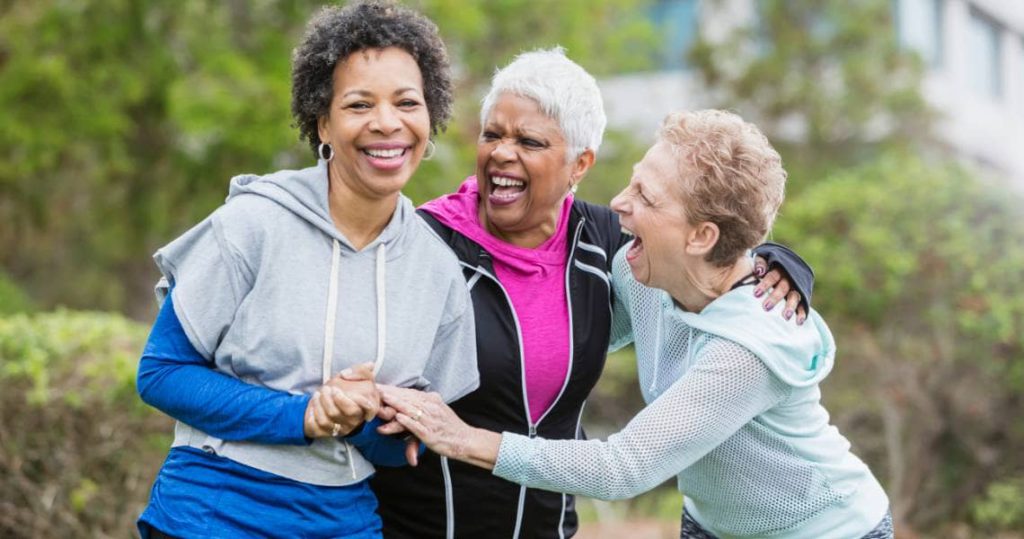
As May ushers in its delightful blend of warmth and freshness, it presents a wonderful opportunity for those over 50 to revitalize their fitness routines in the great outdoors. The gentle morning breeze is perfect as you stroll through dew-speckled parks, and the scenic trails offer a mild yet effective, invigorating, and visually pleasing workout. Cycling is another splendid option, allowing for a light cardiovascular exercise while you enjoy the sight of blossoming landscapes.
Engaging in these activities promotes physical health and enhances mental well-being, which is crucial for maintaining an active lifestyle as we age.
If you’re wondering which activity might be most suitable for you, consider your current fitness level and any health restrictions you might have. Here are some suggestions:
- Walking and Hiking: Start with short distances and gradually increase as your stamina allows. Parks with paved paths can be ideal for those with joint concerns.
- Cycling: Choose a comfortable bike with good support and consider flat, smooth trails that are gentle on your body.
- Gardening: Light gardening is a more relaxed but effective physical activity that also helps with flexibility and strength.
Each option keeps you physically active and connects you with nature. It can also be a wonderful way to meet others with similar interests. Additionally, staying active is key in managing age-related conditions such as arthritis and cardiovascular health.
Always consult your healthcare provider before starting any new exercise program, especially if you have existing health conditions or concerns. They can provide personalized advice that aligns with your health needs and fitness goals.
Moreover, embracing these activities can lead to a richer, more fulfilling lifestyle, enhancing your overall quality of life during these golden years. Whether through solo activities that offer peace and reflection or group settings that provide social interaction, the goal is to remain active, healthy, and engaged in your community.
Key Points
- Discover the joys of walking and hiking in nearby parks or nature reserves to boost your stamina and cardiovascular health. These activities are excellent for maintaining heart health and are gentle on the joints, making them ideal for those in their 50s and beyond. Consider inviting a friend or joining a walking group to make these outings more enjoyable and socially enriching.
- Embrace the benefits of cycling on flat, scenic trails to enhance cardiovascular endurance. Cycling is a low-impact activity that can be adjusted to your comfort level and is perfect for enjoying the beauty of nature with friends or family members. Don’t forget to wear a helmet and check that your bike is in good condition for a safe ride.
- Engage in light gardening to improve your flexibility and strength while nurturing your well-being. Gardening is a peaceful and productive hobby and an excellent way to stay active. It helps with hand dexterity and can be quite meditative, providing physical and mental benefits.
- Participate in outdoor activities designed for your age group to foster social connections and improve mental health. Whether it’s a tai chi class in the park, a senior sports league, or a bird-watching club, these activities can help you meet new friends and enjoy the community.
- Consult with a healthcare provider to tailor outdoor activities to your fitness and health needs. This is important to ensure you engage in activities that benefit your health without risking injury. Your provider can offer advice on balancing physical activity with any chronic conditions or mobility issues you may have.
By integrating these activities into your routine, you can enjoy their numerous health benefits, stay socially active, and continue to live a vibrant and fulfilling life well into your 50s and beyond.
Hiking Local Trails
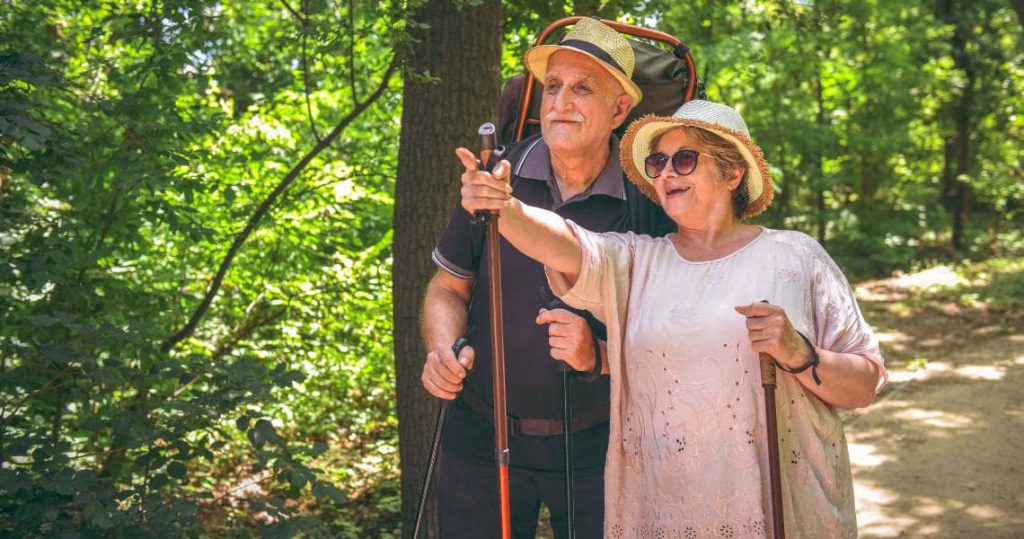
Exploring local hiking trails is a delightful way to connect with nature and an effective way to maintain health and wellness, especially for individuals aged 50 and older. As you lace up your sturdy boots and embark on a trail, you’re not merely setting out on a physical trek but also embarking on a journey that nurtures mind and body.
Hiking is a flexible activity that can be tailored to fit various fitness levels. You can choose paths that suit your physical condition and interests. Engaging in hiking activates numerous muscle groups and serves as a comprehensive cardiovascular workout. Whether it’s a gentle incline or a more strenuous ascent, each step helps increase your heart rate, which is crucial for maintaining cardiovascular health and improving endurance.
This form of exercise is particularly beneficial at this stage of life, as it helps manage or prevent conditions such as heart disease, osteoporosis, and type 2 diabetes. Additionally, hiking offers a wonderful occasion to socialize with peers, friends, or family, encouraging teamwork and strengthening relationships through shared experiences. Walking together in a natural setting can foster meaningful conversations and mutual support, enhancing social connections, which are increasingly valuable as we age.
The mental health benefits of hiking are as important as the physical ones. Immersing yourself in the serene settings of nature can significantly reduce stress and promote mental well-being. The calmness of the outdoors assists in clearing your mind, contributing to improved mood and mental clarity, which is essential for maintaining cognitive health as we age.
For those interested in integrating hiking into their routine, here are a few practical tips:
- Start with shorter trails with minimal incline and gradually increase the distance and difficulty as your stamina improves.
- Wear comfortable, supportive footwear and dress in layers to accommodate changing weather conditions.
- Stay hydrated and bring nutritious snacks like nuts or fruits for sustained energy.
- Consider joining a hiking club or group specifically tailored for those over 50 to combine socializing with physical activity.
Morning Jogging Sessions
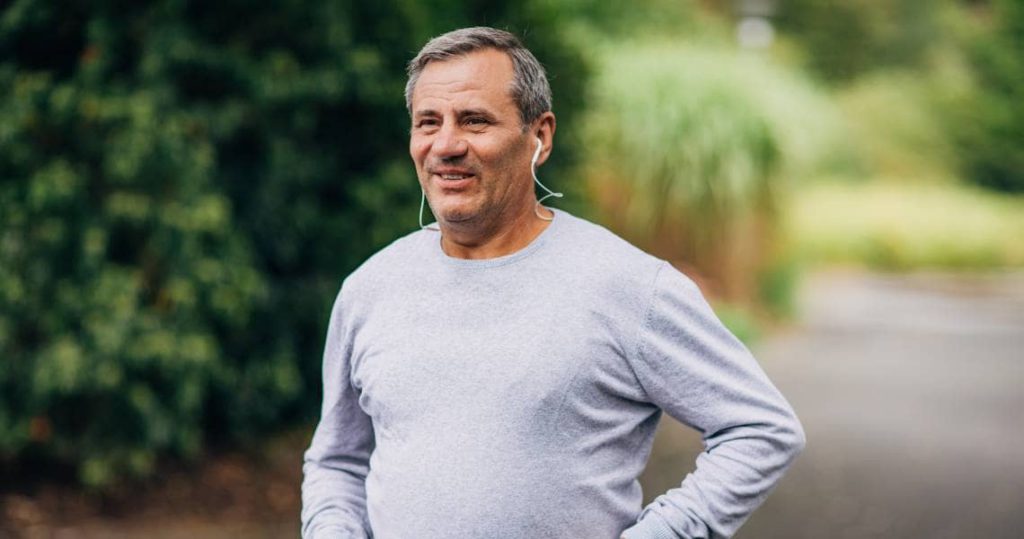
While hiking offers an immersive way to connect with nature, morning jogging sessions provide an equally revitalizing start to your day, especially tailored to the needs and interests of those aged 50 and older.
As you tie up your sneakers and step into the brisk morning air, you’re not just preparing for a productive day; you’re committing to a practice that boosts both your physical and mental well-being.
Jogging in the quiet calm of early morning allows you to savor serene surroundings before the day’s hustle begins. This isn’t solely about maintaining fitness; it’s about carving out a moment of tranquility in an otherwise hectic schedule. The steady cadence of your footsteps paired with the gentle morning breeze is a form of moving meditation, helping clear your mind and enhance your focus for the day’s tasks.
Incorporating a routine of morning jogs can lead to more consistent physical activity, which is crucial for maintaining health as we age. This practice strengthens your commitment to self-care, empowering you to approach each day with renewed vigor and a fresh perspective. More than just physical exercise, morning jogging is a foundational activity that supports your overall health, enhancing your role as a community member, leader, and friend.
Furthermore, the increase in metabolism and the rush of endorphins from a morning jog can elevate your energy levels throughout the day. Imagine navigating your daily activities with greater enthusiasm and a clearer mind, equipped to manage challenges and inspire those around you.
For those in their 50s and beyond, it’s important to approach jogging with mindfulness of your body’s signals. Start with moderate pacing and consider consulting with a healthcare provider if you have pre-existing conditions or concerns. Integrating gentle stretches before and after your jog can also help prevent injuries and enhance flexibility.
Engaging in morning jogs helps you stay physically active and integrates well with a balanced lifestyle that includes proper nutrition and adequate rest. It’s a simple, effective way to ensure you remain vibrant and energetic, ready to enjoy all life offers in your 50s and beyond.
Cycling Through Parks
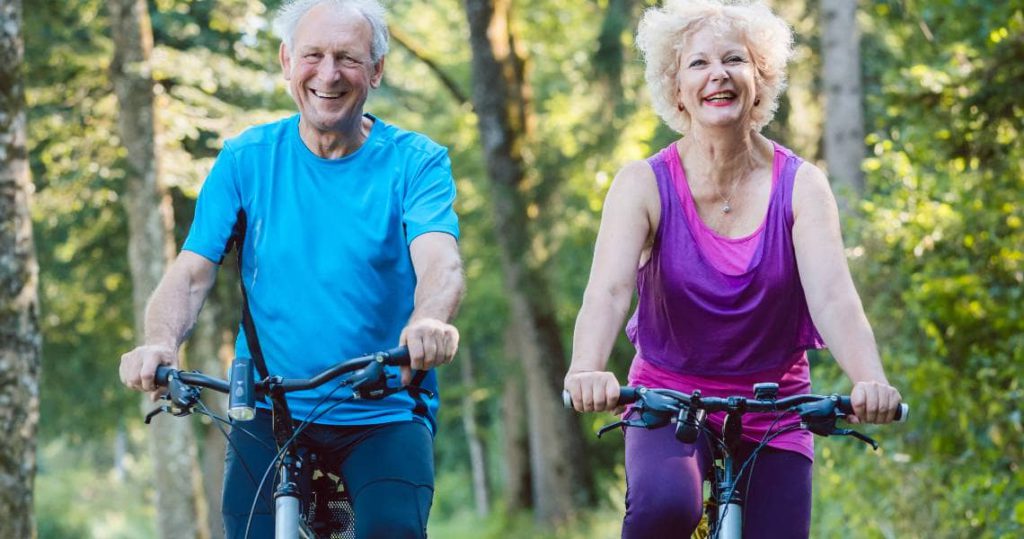
Cycling through parks is a delightful way to elevate your heart rate and an excellent opportunity to immerse yourself in the splendor of nature. This activity offers a refreshing alternative to indoor exercise routines, which is especially appealing as we seek new ways to stay active in our later years. As you pedal along, let the scenic vistas and vibrant landscapes be your companions in a cardiovascular workout that’s both beneficial and enjoyable.
For those of us in the 50+ age group, cycling through parks means opting for a low-impact exercise that we can adjust to suit our individual fitness levels. Whether you’re just starting out or are an experienced cyclist, the varied terrains in parks allow for flexibility in how intense you ride. This adaptability makes cycling a wonderfully inclusive activity, ideal for enjoying with friends or family who might have different fitness objectives or abilities.
Cycling enhances cardiovascular health, strengthens the legs, and improves overall muscle tone. While navigating winding paths and gentle hills, each pedal stroke helps build a stronger, more resilient body. This full-body workout not only aids in calorie burning but also boosts endurance, contributing significantly to a healthier lifestyle as we age.
The benefits extend beyond physical health. Being outdoors and enjoying fresh air while cycling can greatly improve mental well-being. Nature’s tranquil environment has a calming effect, helping to reduce stress and elevate mood, which is particularly valuable during this stage of life when finding peace and joy becomes even more important.
This May, I encourage you to embrace cycling through parks. It’s a powerful way to rejuvenate your fitness routine while enjoying the beauty of spring. Here are a few tips to make your cycling experience more enjoyable and safe:
- Start Slowly: If you’re new to cycling or returning after a break, begin with shorter rides and gradually increase your distance.
- Safety First: Always wear a helmet, use proper signals, and consider reflective clothing for higher visibility.
- Comfort is Key: Invest in a good quality bicycle with appropriate seat height and handlebar positioning to prevent strains.
- Stay Hydrated: Always carry water, especially on longer rides, to keep yourself hydrated.
Cycling at this stage of life can be more than just physical exercise; it can be a joyful journey through nature that nurtures both body and soul. Join the community of fellow older adults who are discovering the joys of staying active through cycling. It’s your path to a healthier, more fulfilling lifestyle.
Swimming in Natural Waters
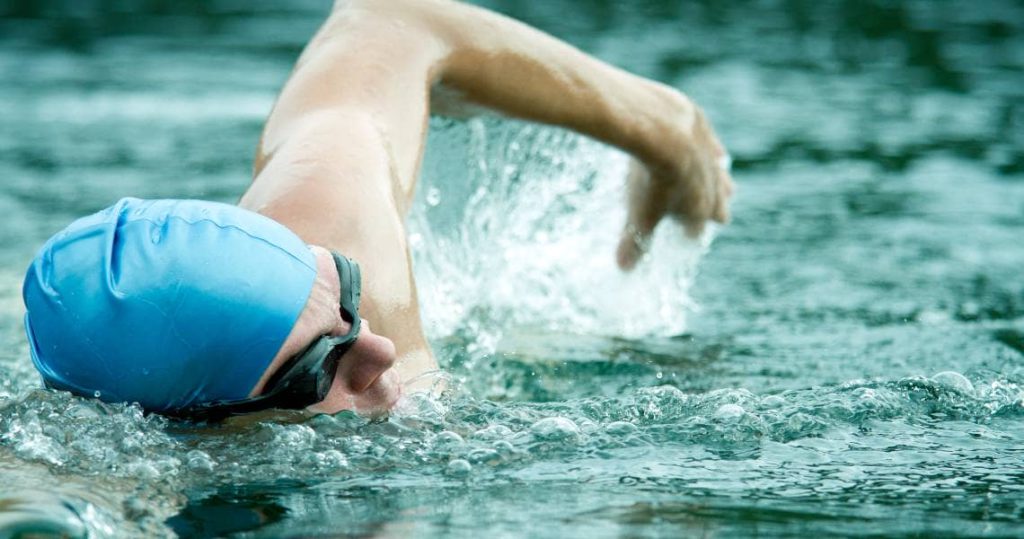
As you venture into the refreshing realm of swimming in natural waters, safety and enjoyment are paramount, especially for those of us aged 50 and older. It’s crucial to understand the unique benefits and considerations of swimming at this stage in life, where maintaining health and embracing leisure activities become even more important.
Firstly, acquaint yourself with the water currents and learn to identify safe swimming conditions. This knowledge is vital as our bodies respond differently to physical stressors as we age. Look for calm, well-known swimming spots that are popular among peers, ensuring a safe environment for your aquatic adventures.
Additionally, consider the benefits of swimming as a low-impact exercise that can help manage or prevent age-related conditions such as arthritis and heart disease. The buoyancy of water offers a gentle resistance, making it an excellent form of aerobic and muscle-strengthening activity, yet easy on the joints.
Remember, it’s never too late to start, but it’s always wise to consult with your healthcare provider before beginning any new exercise regimen, particularly if you have existing health conditions or concerns. They can offer guidance tailored to your health needs and capabilities.
Finally, engage with a community of fellow swimmers who share your interest in natural water swimming. Joining a group can’t only enhance your safety but also increase your enjoyment, providing social interactions that are vital for mental health as we age.
Safety Tips
Why compromise your safety when enjoying natural waters? As you explore the rejuvenating environments of rivers, lakes, or oceans, it’s crucial, especially this May, to prioritize your well-being by staying updated on water conditions. Before you head out, make sure to review the latest water quality reports. These reports are essential as they notify you of potential health hazards such as bacterial contaminations or harmful algal blooms, ensuring that the waters are safe for you and your companions.
Swimming in designated areas under the watchful eye of lifeguards is vital. Lifeguards are proficiently trained to identify and handle emergencies swiftly, significantly increasing your safety. It’s also important to be conscious of natural elements like currents, tides, and sudden changes in water depth, which can quickly transform a peaceful swim into a risky endeavor.
Always swim with a companion. This practice not only enhances safety by ensuring mutual supervision but also provides immediate assistance if necessary. This advice holds particular significance for those of us who enjoy swimming with grandchildren or other young family members. Always keep a vigilant eye on children, as natural bodies of water present unpredictable challenges unlike controlled pool environments.
As we age, it’s essential to continue engaging in activities that promote our health and well-being, but always with an appropriate measure of caution. Swimming and aquatic exercises are excellent for maintaining fitness and flexibility, particularly for those over 50. These activities are low-impact and can be wonderfully invigorating, offering both physical benefits and the joy of being in nature.
Outdoor Yoga Practices

As you embrace the joys of outdoor yoga, finding the ideal spot is crucial—look for a level, tranquil setting that allows you to feel at one with nature. This can be especially soothing and beneficial as you navigate the changes and opportunities of being over 50.
Remember to select a high-quality, non-slip yoga mat and consider supportive accessories like blocks or straps, which are particularly helpful for maintaining balance and reducing strain on joints.
For those just starting or returning to yoga later in life, beginning with gentle poses such as the Tree or Warrior, can boost your confidence and enhance your connection to the practice. These poses also improve balance and strength, key areas of focus for maintaining health as we age.
Integrating yoga into your routine can offer numerous health benefits, including enhanced flexibility, improved posture, and stress reduction. These aspects are particularly important for those over 50, as they contribute to a healthier lifestyle and can alleviate symptoms of chronic conditions like arthritis or lower back pain.
Furthermore, the peacefulness of practicing yoga outdoors can provide a valuable moment of reflection and relaxation, a welcome break from the busy pace of life, particularly if you’re navigating transitions like retirement or adjusting to an empty nest.
When planning your yoga sessions, consider the time of day and the weather conditions—early morning or late afternoon can provide cooler temperatures and a refreshing ambiance. Additionally, inviting a friend or joining a community group can make the experience more enjoyable and socially enriching.
Selecting Your Yoga Space
Incorporating yoga into your routine as you age can be a wonderful way to maintain flexibility, strength, and mental clarity. Finding the right outdoor space for your yoga practice can transform your sessions, allowing you to connect deeply with the tranquility of nature. Here are some considerations to help you choose the perfect spot that caters to the unique needs of those aged 50 and older:
- Peaceful Environment: Choose a quiet area where distractions are minimized, aiding in concentration and enhancing your meditative state. This calmness is crucial as it supports mental focus and stress reduction, which are particularly beneficial as we age.
- Stable, Flat Surface: When practicing yoga poses, it’s important to select a level area to ensure safety and prevent falls. A flat surface will also help maintain balance and confidence.
- Gentle Shade: Opt for a location that offers natural shade to protect against the harshness of direct sunlight, which can be more challenging to tolerate as we age. Shaded areas also make the environment more enjoyable and cooler, which is ideal for longer sessions.
- Pleasing Views: Engaging with beautiful, natural scenery can uplift your spirit and enhance your relaxation and mindfulness. A serene view can contribute to a deeper sense of peace and contentment during your practice.
- Privacy: A secluded spot is preferable to ensure privacy and comfort. This allows for a more personal experience where you can focus on your well-being without interruptions.
In addition to these tips, remember to listen to your body and modify poses to suit your comfort and physical capabilities. Yoga is a flexible practice that can be adjusted to meet your health and mobility levels.
Engaging in yoga outdoors rejuvenates your body and refreshes your mind, making each session a nurturing experience for your health and wellness journey past 50.
Essential Yoga Gear
Enhancing your outdoor yoga experience after 50 can invigorate and benefit your overall health and wellness. Here are some essential items and tips tailored specifically for mature adults seeking comfort, stability, and safety during their practice.
Firstly, a high-quality, non-slip yoga mat is crucial. Balance can become a challenge as we age, and a stable mat provides the necessary support to safely perform yoga poses, even on grass or uneven surfaces. This helps prevent slips and falls, ensuring a secure and enjoyable session.
It is also important to select appropriate yoga attire. Opt for breathable, moisture-wicking clothing that keeps you comfortable while enjoying the morning sun or the cool shade. These fabrics help manage body temperature and sweat, allowing you to focus on your practice without discomfort.
Consider the benefits of yoga blocks and straps. These tools are fantastic for those in their 50s and beyond, as they help maintain proper posture and alignment. They can also be used to modify stretches to suit your flexibility level. This is particularly helpful for adapting to the natural terrain of outdoor settings while reducing the risk of injury.
Another essential item is a lightweight, portable yoga towel. It absorbs excess sweat and provides additional grip on your mat, enhancing stability during your practice.
Lastly, always bring a water bottle to keep hydrated and apply sunscreen to protect your skin from UV rays. Staying hydrated and protecting your skin is crucial for maintaining your health as you enjoy the outdoors.
With these tips and tools, you can confidently engage in yoga, a wonderful activity for maintaining flexibility, strength, and mental clarity in your 50s and beyond. This practice enhances your physical health and provides a peaceful escape to enrich your well-being.
Yoga Poses for Beginners
Now that you have the right gear let’s delve into some yoga poses that are particularly beneficial and enjoyable for those of us in the great outdoors, specially tailored for individuals aged 50 and older. Engaging in yoga outside isn’t merely about physical exercise; it’s an opportunity to harmonize with nature, fostering a peaceful mind and enhanced well-being.
Here are five yoga poses that are ideal for enhancing your outdoor experience, considering your unique health and lifestyle needs:
- Mountain Pose (Tadasana): Stand upright and firmly plant your feet on the ground. This pose is excellent for improving posture and balance, key concerns as we age. It allows you to feel connected with the environment, providing a stable foundation promoting security.
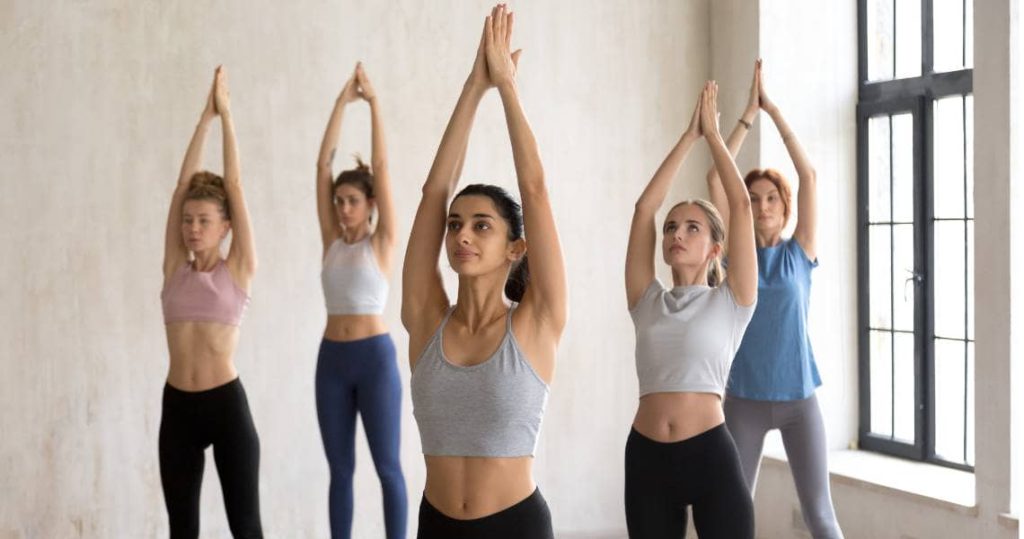
- Downward Dog (Adho Mukha Svanasana): This essential pose helps elongate and strengthen the spine, which is crucial for maintaining good health and agility as we get older. It also improves circulation and provides a gentle inversion, which can be refreshing and energizing. Viewing the world from this new angle can also offer a fresh perspective on your surroundings.
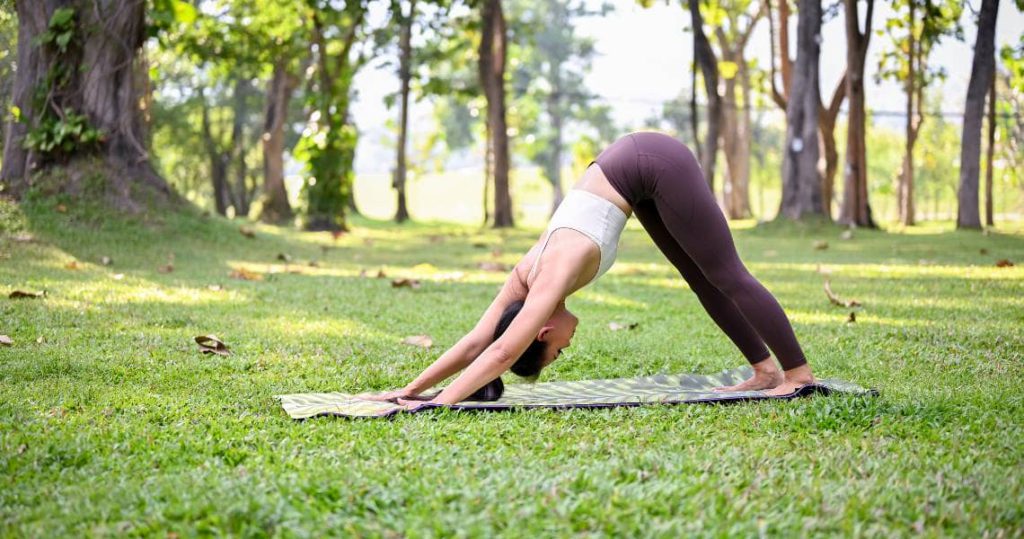
- Child’s Pose (Balasana): This soothing pose is perfect for moments of rest. It allows for deep relaxation and introspection, which can be particularly valuable in managing stress and fostering mental clarity—essential for maintaining emotional health.
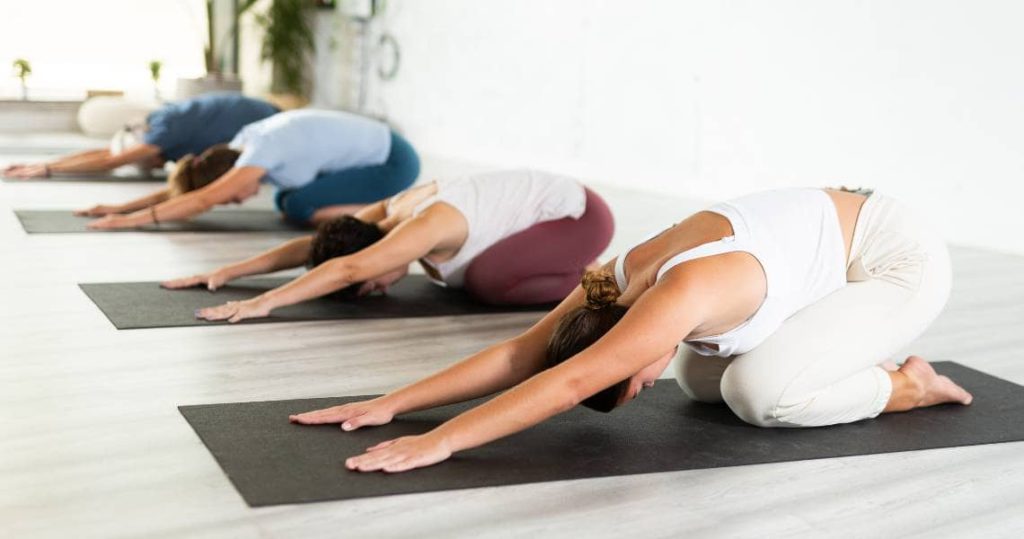
Warrior II (Virabhadrasana II): This pose builds lower body strength and stamina. It opens your hips and chest, promoting better breathing and endurance. Gazing over the horizon, you feel a sense of accomplishment and connection to the world around you, enhancing your emotional resilience.
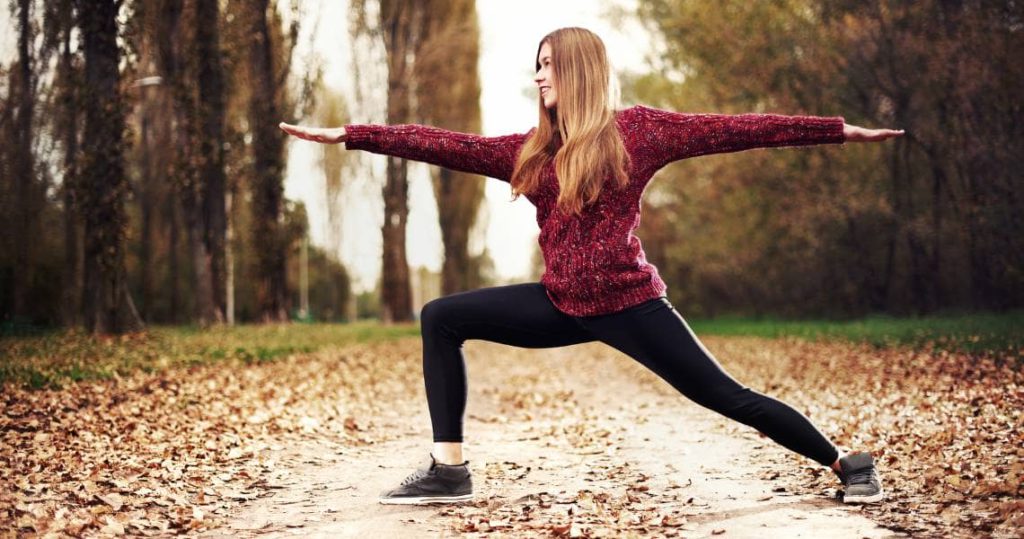
- Seated Forward Bend (Paschimottanasana): This gentle forward fold is excellent for stretching the back muscles and hamstrings, which can become tight and restrictive with age. It encourages a peaceful, introspective state, allowing you to open your heart toward the vast sky and embrace the space and freedom around you.
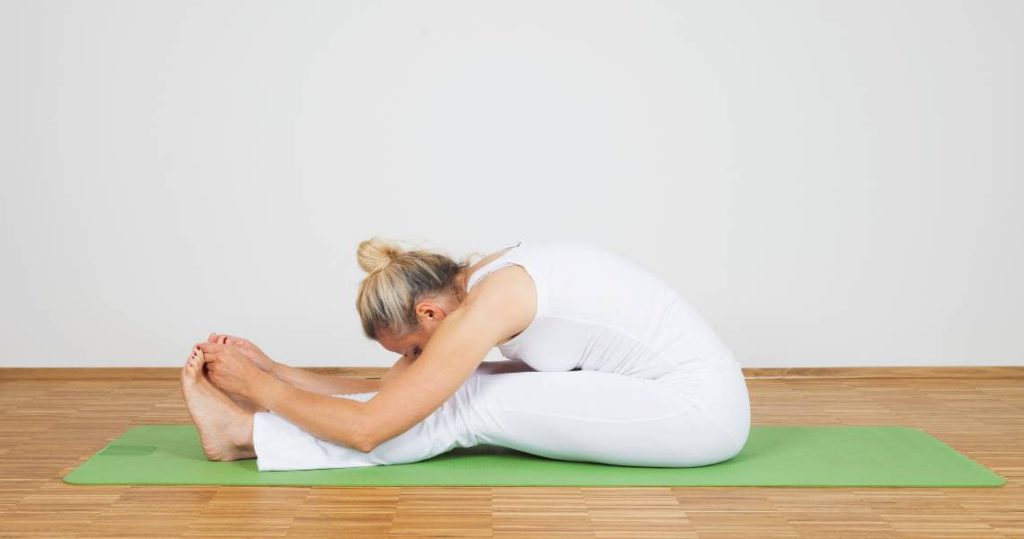
These poses aren’t just beneficial for improving flexibility and strength, but they also enhance mindfulness and overall quality of life, making your outdoor yoga practice a rejuvenating retreat for both body and spirit.
Remember to listen to your body and modify any poses to suit your comfort level, possibly using props like a chair or yoga block. Embracing yoga as part of your routine can be a powerful tool for maintaining vitality and joy in your 50s and beyond.
Community Sports Leagues

Joining a community sports league can be a rewarding experience, especially for those aged 50 and above, offering not just physical benefits but also a chance to connect with peers and enjoy a fulfilling social life. Whether you’re an experienced athlete or are seeking ways to stay active, sports like soccer, basketball, and softball provide ample opportunities tailored to every skill level, ensuring a welcoming and inclusive atmosphere.
For adults in this age group, engaging in regular physical activities through these leagues can significantly aid in managing age-related health concerns such as cardiovascular health and joint flexibility. The structured schedule of games and practices offers the perfect motivation to maintain regular exercise, which is crucial for a healthy lifestyle.
The camaraderie formed within these teams is particularly beneficial during the post-retirement years, fostering a sense of community and ongoing social engagement. This social interaction is essential, as it combats loneliness and promotes mental well-being, helping to alleviate stress and prevent depression.
Moreover, participating in a sports league can be an excellent way to enjoy the outdoors and stay connected with nature, further enhancing your mental health. The joy and satisfaction of playing and collaborating with teammates can be incredibly uplifting and transformative.
For practical advice tailored to those over 50, consider starting with lighter training sessions and gradually increasing the intensity to suit your comfort level. Always consult a healthcare provider before beginning any new exercise regimen, especially if you have pre-existing health conditions or concerns. Also, ensuring proper hydration and wearing appropriate gear can help avoid injuries and make your sports experience more enjoyable.
Rock Climbing Adventures
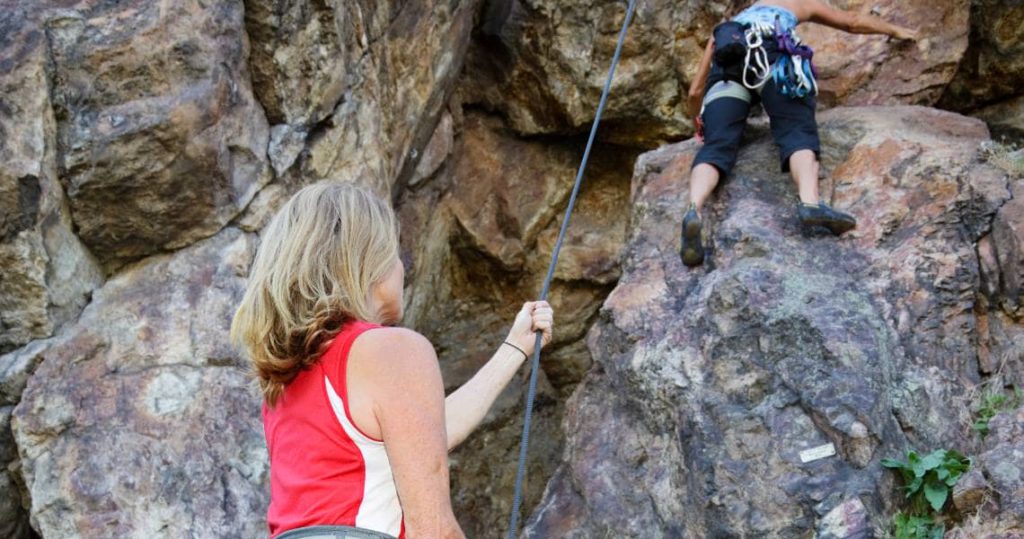
As you prepare for rock climbing adventures, choosing the right equipment that ensures comfort and safety, particularly if you’re in the vibrant over-50 age group is crucial. Climbing offers a thrilling challenge and a fantastic way to stay active and engage with nature’s beauty, which is increasingly important as we age.
Understanding and mastering essential safety techniques are key to confidently tackling climbs while minimizing risks. This is especially pertinent for those managing age-related health changes, ensuring that every climb is as safe as it’s enjoyable.
Seeking out the best local climbing spots can offer dual benefits: enhancing your climbing skills and immersing you in breathtaking natural scenery. These locations are often peaceful retreats from everyday life and provide a serene environment to reflect, rejuvenate, and connect with fellow climbing enthusiasts who share your passion and respect for the sport and the great outdoors.
For those in their 50s and beyond, it’s also a splendid opportunity to integrate social interactions with physical activity, which can contribute positively to mental health and emotional well-being. Climbing with peers or joining a community of like-minded individuals can add a valuable social element to your exercise routine, making it more enjoyable and sustainable.
When planning your climbing outings, consider the following practical advice:
- Choose the Right Gear: Opt for high-quality, durable climbing equipment that accommodates any physical limitations such as joint sensitivity or reduced mobility. Equipment should have ergonomic features that enhance comfort and safety.
- Start Gradually: Begin with easier climbs and gradually increase the difficulty as your confidence and skills improve. This approach helps prevent injuries and builds endurance effectively.
- Stay Informed: Keep up-to-date with the latest climbing techniques and safety protocols. Participating in workshops or classes can be an excellent way to learn and meet peers.
- Listen to Your Body: Pay attention to what your body tells you during and after climbs. Adjust your activities to avoid overexertion, and ensure enough hydration and nutrition.
- Consult Healthcare Providers: Before embarking on any new physical regimen, check with your healthcare provider, especially if you have pre-existing conditions or concerns about your physical capabilities.
This engaging hobby strengthens your body and enriches your mind, providing a holistic approach to maintaining your health and vitality well into your 50s and beyond. Happy climbing!
Choosing Your Climbing Gear
Selecting the right climbing equipment is crucial for both your safety and enjoyment, especially as you embrace the adventures of climbing during your 50s and beyond. Climbing can be a wonderful way to maintain fitness, challenge yourself, and enjoy nature. Here’s how to choose gear that suits your needs, keeping in mind the specific considerations for those seasoned in years but young at heart.
Climbing Shoes: Look for shoes that balance comfort and precision well. At this stage, it’s vital to opt for shoes that won’t overly strain your joints, particularly if you have any foot issues or arthritis.
Harness: Comfort is paramount when selecting a harness. Ensure it fits well without being too restrictive and has enough gear loops for your essentials. A well-fitting harness is crucial for safety and confidence on the climb.
Helmets: Protecting your head should always be a priority. Choose a helmet that’s lightweight yet sturdy to keep you safe from any potential impacts or falling debris without straining your neck muscles.
Climbing Ropes: Opt for ropes appropriate for the type of climbing you’ll be doing. Consider ropes that are durable and manageable in weight to make handling easier and reduce strain.
Protection Gear (Cams, Nuts, Quickdraws): It’s important to have reliable protection gear that you can easily operate. Familiarize yourself with the latest and most user-friendly gear, which can provide peace of mind and safety.
Additional Tips for the Aged 50 and Over Climber:
- Pacing Yourself: Start with shorter, less demanding climbs and gradually increase the difficulty as your comfort and fitness improve.
- Warm-Up and Stretch: Always warm up your muscles and stretch before a climb to minimize the risk of injuries.
- Hydration and Nutrition: Keep hydrated and bring nutritious snacks to maintain energy levels throughout the climb.
- Listening to Your Body: Pay attention to what your body tells you. If you feel pain or fatigue, it’s wise to consider that in your climbing plans.
Climbing in your 50s and beyond isn’t just about keeping physically active; it’s also a fantastic way to connect with friends or make new ones, enjoy the outdoors, and experience a sense of accomplishment. With the right gear and a thoughtful approach, climbing can continue to be a rewarding part of your lifestyle, offering both challenges and joy.
Essential Safety Techniques
Equipping yourself with the right climbing gear is just the beginning of ensuring that your rock climbing experiences are both exhilarating and safe, especially as we age. At 50 and beyond, it’s crucial to take extra precautions to maintain our adventure spirit while safeguarding our health.
Here’s how to enjoy rock climbing safely and responsibly:
Firstly, always securely fasten your harness and meticulously double-check all equipment before you begin. This step is crucial not only for your own safety but also to ensure you’re a dependable partner. As we age, our reflexes mightn’t be as sharp as they used to be, making it even more vital to rely on well-maintained gear.
Effective communication is key. Establish a clear and simple system of signals with your climbing partner. This is particularly important as it helps prevent misunderstandings that could lead to accidents. Opt for direct and straightforward messages, which will help both of you stay coordinated and informed.
Next, focus on mastering belaying techniques. Proper belaying is essential as it acts as a safety net, preventing falls and ensuring the well-being of your climbing partner. Regular practice of these techniques is advisable, as proficiency in belaying can significantly enhance safety for you and your climbing companion.
Be aware of potential hazards such as loose rocks and slippery surfaces, which can be more challenging to navigate as we grow older. Additionally, keep an eye on the weather conditions, as changes can occur quickly and affect your climbing experience.
Lastly, consider participating in a rock climbing course designed for older adults or training sessions with seasoned climbers who can share insights tailored to your age group. Such experiences can be invaluable, helping you refine your skills and contribute positively to every climb.
Incorporating these safety strategies into your climbing routine can help maintain an active and fulfilling lifestyle, ensuring that you continue to enjoy your passion for rock climbing well into your later years. Remember, it’s about balancing the thrill of the climb with the wisdom to do it safely.
Best Local Climbing Spots
Explore Prime Climbing Locations Tailored for Adventurous Spirits Aged 50 and Beyond
Rock climbing transcends age, offering a thrilling adventure combining physical exercise and mental stimulation. As you’ve reached or are enjoying your golden years, discovering local climbing spots can be a delightful way to maintain health, meet new friends, and experience the beauty of nature in a safe and rewarding manner. Here’s a thoughtful guide designed to help you embrace rock climbing adventures, perfectly suited to those aged 50 and older.
- Senior-Friendly Climbing Gyms: These gyms provide an excellent starting point, offering programs specifically tailored for older adults. They focus on safety, technique, and building endurance at a comfortable pace. Many also organize social climbing groups or outings, which are fantastic opportunities to connect with peers.
- Gentle Natural Rock Formations: Look for climbing areas that are known not only for their scenic views but also for having a range of easier routes. These spots are ideal for beginners or those preferring a more relaxed climb. Each formation presents a unique challenge that respects your pace and physical capabilities.
- Guided Climbing Tours: Opt for tours that cater to older adults. These tours offer expert guidance through lesser-known trails and provide insights into climbing safely and efficiently. They also handle the logistics, so you can focus on enjoying your climb and the surrounding landscape.
- Climbing Clubs for Older Adults: Joining a community club can enrich your climbing experience. These clubs often have members who share similar interests and lifestyles, including the desire to stay active in later life. They can also be a great source of tips and support for new climbers.
- Seasonal Climbing Events: Participate in events specifically designed for climbers over 50. These events aren’t only about climbing but also celebrate your ongoing enthusiasm for adventure and fitness, often held in breathtaking locations that are worth the trip alone.
Rock climbing as a senior offers more than just physical benefits; it’s a gateway to lifelong learning and an active social life. It challenges the body and the mind, helping maintain muscle strength, flexibility, and cognitive function. Embrace these climbing adventures, and you’ll discover that they transform your physical health and enrich your spirit and social life.
This guide is just the beginning of what can be a fulfilling journey into the world of climbing, tailored specifically to meet your needs and ensure your safety and enjoyment. Whether you’re looking to challenge yourself, stay fit, or simply enjoy nature from a new perspective, rock climbing has something wonderful to offer.
Paddleboarding on Lakes

Paddleboarding on lakes offers a serene and invigorating escape, perfect for those over 50 looking to enhance their physical health and mental well-being. As the days grow warmer, Stand-Up Paddleboarding (SUP) presents a delightful combination of leisurely enjoyment and active lifestyle, ideal for maintaining strength, balance, and overall fitness in a gentle manner.
Gliding over the calm waters provides not only a peaceful retreat but also a comprehensive workout. Each paddle stroke helps to strengthen your arms and engage your core, without the harsh impact on your joints often associated with other forms of exercise. This makes SUP an excellent option for those mindful of maintaining joint health and physical vitality.
Moreover, SUP stands out as a low-impact exercise accessible to people at different fitness levels. It effectively burns about 430 to 500 calories per hour, offering a wonderful way to manage weight while soaking in the beauty of nature. The rhythmic motion of paddling can also serve as a meditative practice, aiding in stress relief and promoting mental clarity—a crucial aspect of wellness as we age.
Exploring lakes on a paddleboard also allows you to connect closely with nature. Picture yourself paddling near the shoreline, observing fish darting below the water’s surface or birds nesting in the trees. These encounters can deepen your appreciation for the environment and enrich your paddleboarding experience, turning each outing into both a physical exercise and a rejuvenating nature therapy.
For those in their 50s and beyond, engaging in activities like SUP can contribute significantly to a balanced lifestyle, ensuring active days filled with joy and tranquility. It’s a wonderful way to stay engaged, meet new friends who share similar interests, and enjoy the outdoors while respecting your body’s needs.
When considering paddleboarding, it’s advisable to start with a beginner’s class to familiarize yourself with the techniques and safety measures. Always check with your health provider before starting any new exercise regimen, especially if you have underlying health conditions.
Trail Running Escapades
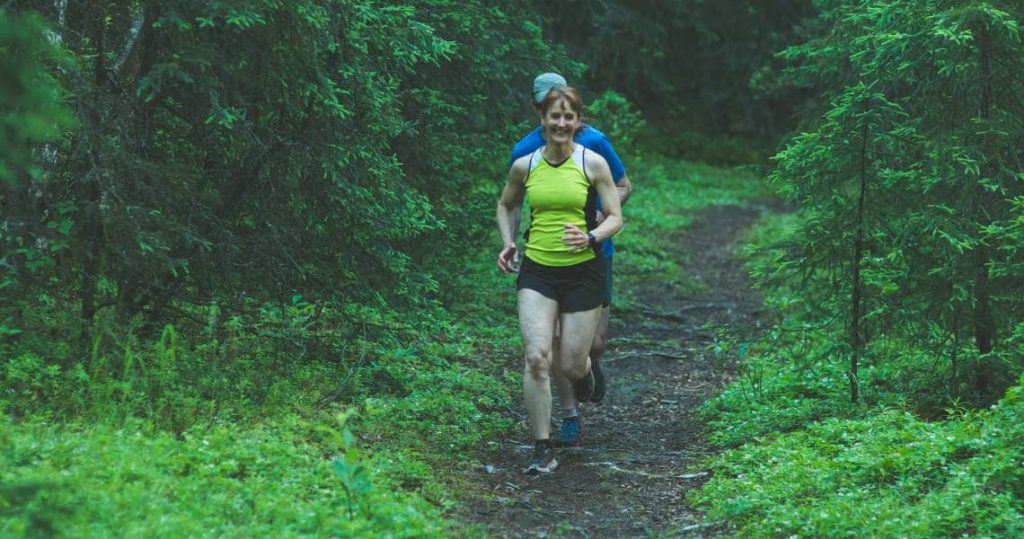
If you’re looking for a refreshing way to stay active and embrace the great outdoors, trail running might be just the activity you need. As the landscapes awaken in May, it’s a prime time to engage with nature while giving your fitness a boost.
Trail running isn’t solely about endurance; it’s a holistic exercise that nurtures both your body and mind, making it especially beneficial for those in their 50s and beyond.
Here are compelling reasons to incorporate trail running into your exercise regime:
- Varied Terrain: Trail running offers a change from the flat, predictable surfaces of road running or treadmills. The varied landscapes, with their mix of mud, rocks, and roots, not only keep your run interesting but also engage different muscle groups, helping to improve your physical stability and strength.
- Natural Scenery: Immersing yourself in nature’s embrace has profound mental health benefits. The peaceful environments of trails can help lower stress and elevate your mood, contributing to your emotional well-being.
- Enhanced Coordination: Trails require you to adjust swiftly to changing terrains, which sharpens your reflexes and boosts your coordination and balance. These are vital skills, particularly as we age, helping to reduce the risk of falls.
- Cardiovascular Health: Engaging in trail running is an excellent cardiovascular workout. The effort of climbing hills and navigating obstacles can increase your heart rate, which is crucial for maintaining heart health as we grow older.
- A Break from the Indoors: Moving your exercise routine outdoors is a refreshing change from indoor workouts. The fresh air and sunlight aren’t only invigorating but also essential for boosting Vitamin D levels, which are important for bone health and immune function.
Trail running is an adaptable activity, suitable whether you’re an experienced runner or just looking to add a new challenge to your fitness routine.
As you consider new ways to stay active, trail running offers both physical and mental benefits, making it a worthwhile addition to your healthy lifestyle. So why not embrace the adventure this May and explore the beauty of nature on the trails?
Outdoor Fitness Bootcamps
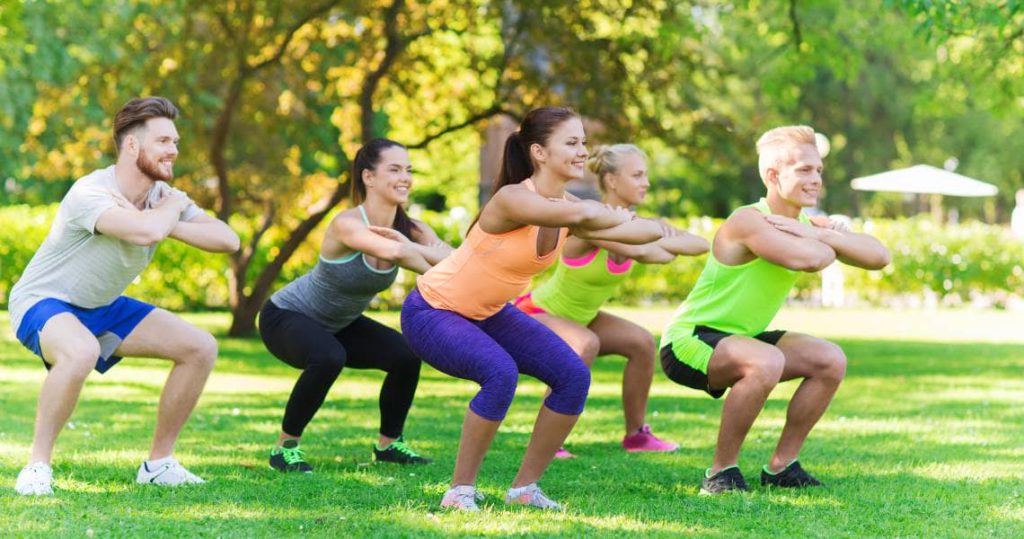
Outdoor fitness bootcamps offer a refreshing way to stay active for those aged 50 and above, combining low-impact high-intensity interval training, bodyweight exercises, and the spirit of teamwork in the natural outdoors. With the inviting weather of spring, it’s a perfect opportunity to enjoy the outdoors and engage in physical activity that respects your body’s needs.
These bootcamps are designed with the understanding that fitness at 50 and beyond involves more than just physical exercise; it’s about maintaining overall health, strengthening social bonds, and enjoying life’s vibrant moments. Led by trainers experienced in catering to mature adults, each session focuses on cardiovascular health, muscle strengthening, and flexibility—a trio crucial for long-term mobility and wellness.
Participating in a bootcamp can be a transformative experience for your fitness routine. The group setting not only motivates but also adds a layer of accountability, making it less likely for you to miss a session when your peers are expecting you. The camaraderie developed through shared experiences enhances the joy and satisfaction of each workout.
Envision yourself greeting the sunrise with a fulfilling workout, surrounded by the tranquility of nature and the supportive energy of your group. This isn’t just about physical improvement; it’s about nurturing your mental and emotional well-being too. Engaging in outdoor fitness bootcamps this season is an excellent way to energize both body and mind, while also contributing positively to your community through collective effort and support.
We invite you to embrace the challenges and rewards of these outdoor fitness bootcamps. They aren’t just a means to stay fit, but a gateway to a more active, connected, and fulfilling lifestyle as you navigate the exciting years of your 50s and beyond.
Kayaking Along Rivers
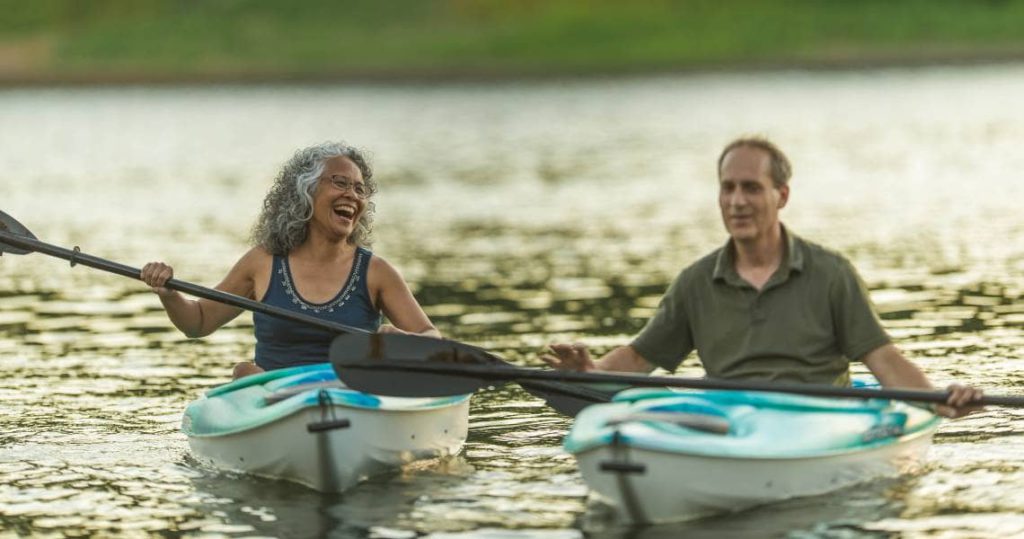
Embarking on a river kayaking adventure can be a thrilling and rejuvenating activity, especially if you’re embracing the golden years of life post-retirement. As you plan your journey, it’s crucial to equip yourself with not only the right gear but also the knowledge to ensure a safe and enjoyable experience.
Firstly, choosing a sturdy kayak that offers good stability and comfort is essential, as it will help accommodate any physical limitations and ensure ease of use. Pair this with a life jacket that fits well—safety is paramount, no matter your age or skill level.
In addition to the kayak and life jacket, investing in waterproof bags is wise to protect your essentials like medications, which may need to be readily accessible. This precaution not only safeguards your belongings but also provides peace of mind as you navigate through the waters.
Understanding river navigation is equally important. Familiarize yourself with reading water currents and identifying safe passage routes. This knowledge is vital for maintaining safety and enhancing your enjoyment as you paddle. It’s a wonderful way to stay active and engaged with nature, which is beneficial for both physical health and mental well-being.
Moreover, consider the benefits of kayaking as a low-impact exercise that can help maintain joint health, flexibility, and cardiovascular fitness. It’s also a fantastic opportunity to socialize with peers or loved ones in a serene environment, fostering emotional connections and strengthening bonds.
Before setting out, consult with healthcare providers to ensure that this activity is suitable for your health status, particularly if you manage chronic conditions. They might offer advice tailored to your needs, ensuring a comfortable and safe experience.
Lastly, remember to enjoy every moment on the river. Kayaking at this stage of life isn’t just about physical activity but also about enjoying the beauty of nature, the peace of flowing waters, and the joy of life’s simple pleasures. Embrace these moments with enthusiasm and a heart open to adventure.
Essential Kayaking Gear
Embarking on a river kayaking adventure can be both exhilarating and restorative, especially as we embrace the golden years. Whether you’re seeking a serene paddle down a gentle river or a bit more excitement in rapids, proper preparation is key to ensuring a safe and enjoyable experience.
Here’s a tailored guide to the essential kayaking gear for those aged 50 and older, focusing on safety, comfort, and ease of use.
- Kayak and Paddle: Choosing the right kayak is crucial. Opt for a stable and comfortable kayak that suits river conditions. Look for models with ergonomic features that reduce strain on your back and joints. Ensure the paddle is the correct length to prevent overexertion, and lightweight materials can help manage energy levels throughout the journey.
- Personal Flotation Device (PFD): Safety is paramount at any age. Select a PFD that’s specifically designed for paddling and offers both comfort and mobility. Ensure it fits snugly without restricting breathing or movement.
- Water Shoes: Invest in high-quality water shoes that offer good support and slip-resistant soles. Proper footwear protects against rocky riverbeds and helps prevent falls, keeping you steady both in and out of the kayak.
- Safety Whistle: A loud whistle is an essential safety tool for signaling help. It’s simple to use and can be a lifeline in emergency situations.
- Waterproof Bags: Keep essentials like medication, snacks, and a waterproof phone case dry and secure. Choose bags with easy-to-open closures, particularly useful for those with limited hand dexterity.
Kayaking offers significant health benefits, including improved cardiovascular health and muscle strength, and is a wonderful way to connect with nature. As you prepare for your river kayaking adventure, remember to consider your physical capabilities and comfort. Always check with a healthcare provider before embarking on new physical activities, and consider kayaking with a group or guide, especially if you’re just starting out or if the river conditions are challenging.
This guide aims to prepare you thoroughly, ensuring your kayaking experience isn’t only safe but also incredibly rewarding. Here’s to enjoying the great outdoors and the many benefits of staying active and engaged in your 50s and beyond!
River Navigation Tips
Equipped with the right gear, let’s delve into how to master river kayaking safely and enjoyably, particularly tailored for those of us in our golden years. River kayaking isn’t only a peaceful way to reconnect with nature, but it also serves as an excellent full-body exercise that’s both gentle and effective for maintaining fitness after 50.
When choosing a kayak, it’s crucial to select a type that suits your needs and the river conditions. Sit-on-top kayaks are perfect for warmer climates and easier re-entry if you capsize – a practical feature as we prioritize ease and safety. Alternatively, sit-inside kayaks provide enhanced protection against cooler waters, which is beneficial for those of us who might be more sensitive to cold temperatures.
Paddling should be done with a steady rhythm, utilizing your core muscles to steer and balance, which is an excellent way to strengthen these vital muscles, crucial for everyday activities. This technique not only helps in maintaining endurance but also ensures better control in flowing river currents. Be mindful of the water’s behavior; swift currents or areas with debris require careful navigation. It might be wise to avoid these more challenging areas to ensure a safe kayaking experience.
Always remember to wear your life jacket and consider kayaking with a companion or a group. This not only enhances safety but can also make the experience more enjoyable as you share the beauty of nature and the joys of active living with peers.
Beach Volleyball Games
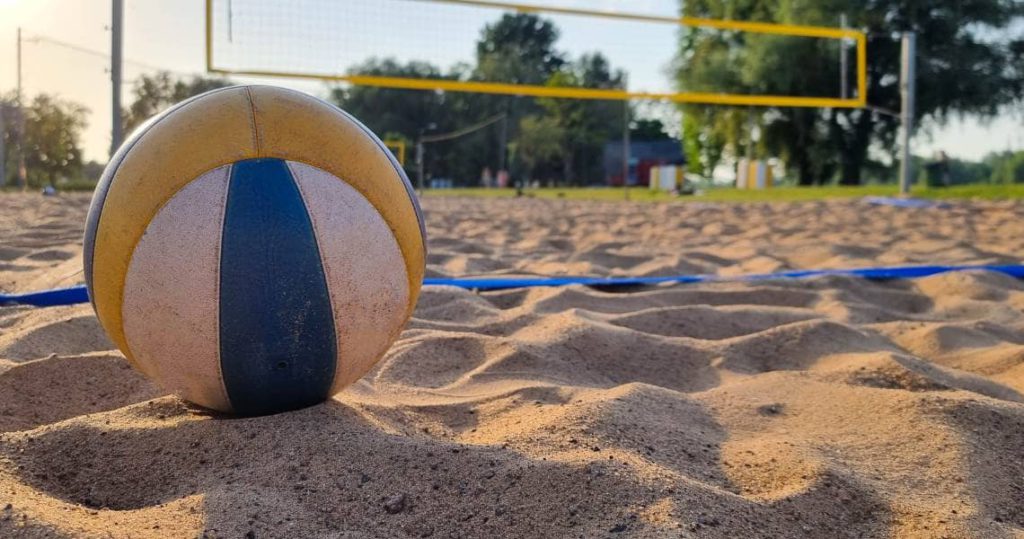
Beach volleyball offers a delightful and effective way for those over 50 to maintain fitness while enjoying the sunshine and fresh air of the beach. This sport is more than just a leisurely activity; it’s a comprehensive exercise that promotes physical health and mental well-being, perfectly suited for older adults who are looking to stay active in an enjoyable and low-impact manner.
Playing beach volleyball has several benefits tailored to the needs and interests of those aged 50 and older:
- Calorie Management: Participating in a game can help you burn around 600 calories per hour, making it an excellent activity for weight management at a stage when metabolism often slows down.
- Improved Flexibility and Balance: The soft sand challenges your balance and strengthens your muscles, which are crucial for preventing falls and maintaining mobility as you age.
- Heart Health: The continuous movement during a game keeps your heart rate elevated, which is important for cardiovascular health, especially in later years.
- Social Interaction: Volleyball encourages teamwork and communication, providing a fantastic opportunity to strengthen social ties and enhance mental health through peer interaction.
- Beautiful Surroundings: The scenic beach environment not only uplifts your spirit but also offers a calming backdrop that can enhance the overall exercise experience, contributing to mental and emotional well-being.
Practical Tips for Engaging in Beach Volleyball Post-50:
- Start Slowly: If you’re new to the sport or returning after a break, begin with shorter sessions and gradually increase your playtime as your endurance improves.
- Stay Hydrated: Always bring water to the beach to stay hydrated, especially as older adults are more susceptible to dehydration.
- Use Proper Gear: To protect yourself from the sun, wear sunglasses and a hat and apply sunscreen. Consider knee pads and ankle supports for additional safety.
- Warm-Up and Cool Down: Incorporate a gentle warm-up to prepare your body for the activity and a cool-down period afterward to reduce muscle stiffness.
- Consult with Your Doctor: Before starting any new exercise regimen, including beach volleyball, it’s wise to consult with your healthcare provider, especially if you have pre-existing health conditions.
Gardening as Exercise
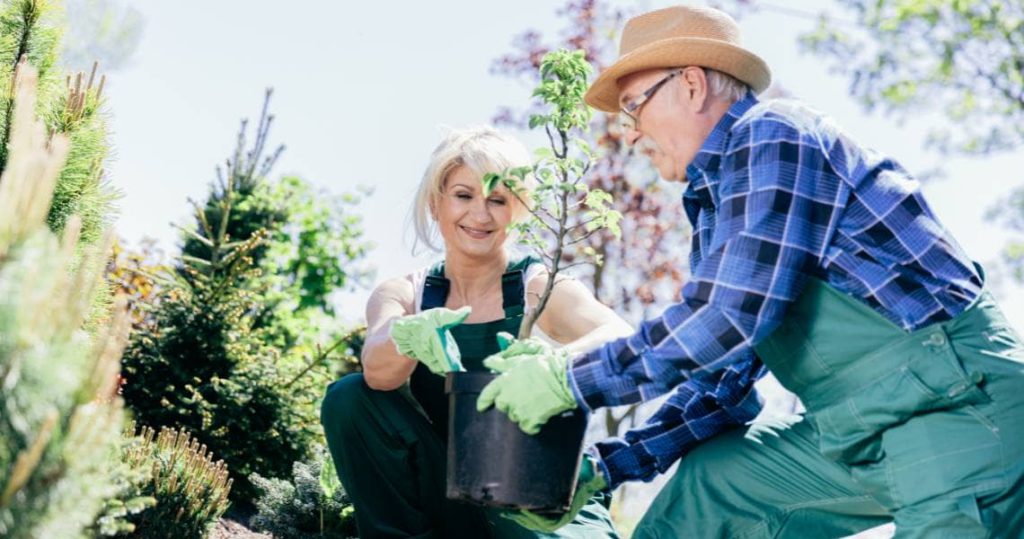
Gardening isn’t merely a tranquil pastime; it’s a valuable form of exercise particularly beneficial for those over 50. Engaging in gardening activities like planting, weeding, and digging helps burn calories and strengthens muscles, a crucial aspect of maintaining physical health as we age. Imagine enjoying the fresh air while burning approximately 200 to 400 calories in just half an hour of gardening this spring. It’s an excellent way to supplement your fitness routine, particularly if you want to stay active in a gentle, low-impact manner.
As you tend your garden, each movement, from shoveling soil to stretching for that far-reaching weed, contributes positively to your physical health. These activities enhance flexibility, vital for joint health as we mature, and improve dexterity, helping to keep your hands and fingers agile. Gardening offers a full-body workout that can fortify your arms, legs, buttocks, and back, and it’s especially good for strengthening core stability, which is essential for good posture and balance.
Beyond the physical benefits, gardening offers significant mental health advantages. The peace of engaging with the earth and the joy of nurturing plant life can greatly reduce stress and elevate one’s mood. For many people over 50, finding serene activities that connect us with nature and provide a sense of accomplishment is key to enhancing our overall well-being.
Here are a few tips to make gardening an even more fruitful part of your health regimen:
- Start with small, manageable projects to avoid overexertion.
- Use ergonomic tools to ease the strain on your joints and muscles.
- Keep your garden accessible to avoid unnecessary bending and stretching, perhaps by using raised beds or containers.
- Wear a hat and sunscreen and protect yourself from the sun.
Gardening isn’t only a delightful hobby but also a holistic exercise that can contribute to a healthy lifestyle as we age. It’s a wonderful way to stay physically active and mentally sharp, ensuring that our golden years are full of vitality and joy. Whether you’re a seasoned gardener or just starting to explore this rewarding activity, the health and happiness benefits are plentiful.
Nature Photography Walks
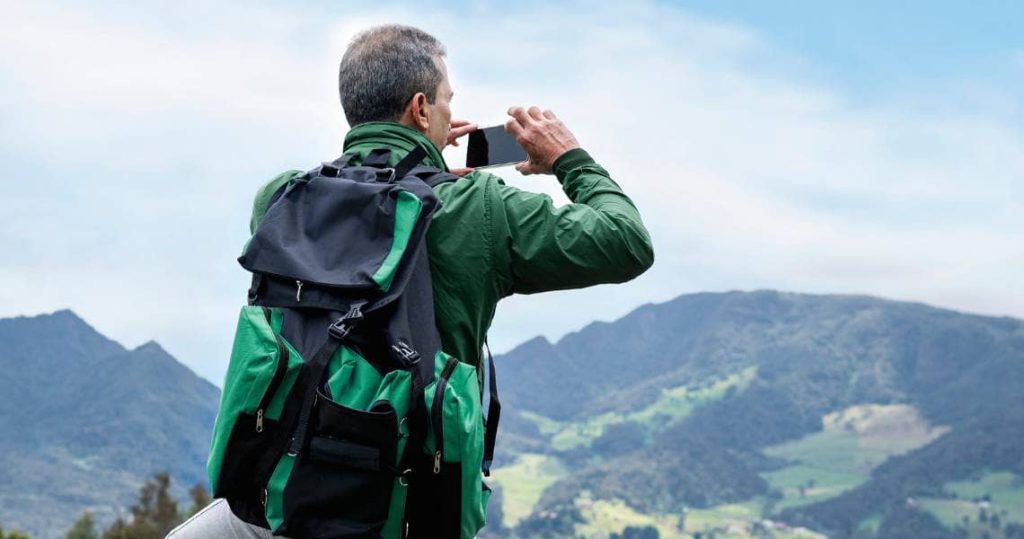
Have you ever thought about enriching your fitness regimen with the serene activity of nature photography walks? Venturing into the vibrant spring outdoors revitalizes your physical health and enriches your mental acuity.
For those of us in our golden years, nature photography walks offer a perfect blend of gentle physical exercise, artistic exploration, and a renewed appreciation for nature’s wonders.
During these walks, you’ll engage all your senses as you capture the beauty of unfolding landscapes, dynamic wildlife, and detailed plant life. This isn’t merely about taking photos; it’s an immersion into the tranquility of nature, viewed through a fresh perspective.
Such activities encourage you to explore different viewpoints and compositions, honing your photography skills while providing a tranquil and reflective experience.
Here’s why you should consider nature photography walks this May, especially tailored for those aged 50 and older:
- Gentle Exercise and Creativity: Merge low-impact physical activity with creative expression, benefiting your physical and mental well-being.
- Connection with Nature: Cultivate a deeper appreciation for the natural environment, observing often overlooked details.
- Skill Enhancement: Gradually improve your photography skills, which can be a fulfilling hobby to pursue.
- Mindful Exploration: Experience a calming quality as you focus on capturing the beauty around you, which can be incredibly meditative.
- Sensory Engagement: Utilize all your senses to absorb and document the enchanting surroundings fully.
As you embark on nature photography walks, you’re enhancing your physical health and nurturing your mental well-being. This activity is an excellent way to maintain mobility, engage with a community of like-minded individuals, and enjoy the therapeutic benefits of being outdoors.
Embrace this opportunity to nourish your spirit by deeply connecting with the natural world.
Whether you’re looking to find a new hobby in retirement or simply wish to stay active in a manageable way, nature photography walks are a delightful option to consider. They offer the dual benefits of keeping you physically active and mentally stimulated, key components in maintaining a vibrant lifestyle as we age.
Frisbee in the Park
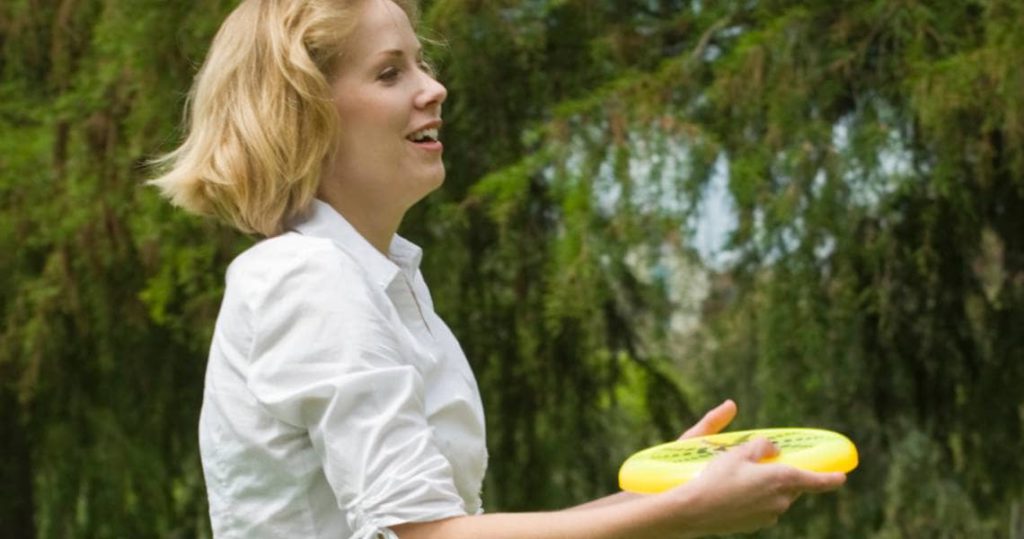
Frisbee in the park provides a delightful and low-impact way to maintain physical agility and coordination, perfect for those aged 50 and older. This simple game isn’t just about leisure; it’s a gentle yet effective exercise that can help enhance your hand-eye coordination, balance, and overall physical health — all crucial aspects as we age.
Engaging in a game of Frisbee allows you to enjoy the outdoors and the beauty of nature, which can be incredibly therapeutic. As you walk or lightly jog across the grass to catch the flying disc, you also take care of your cardiovascular health. The game’s pace can be easily adjusted to match your comfort level, making it an excellent choice for both fitness beginners and those more accustomed to physical activity.
The beauty of playing Frisbee lies in its versatility. It requires minimal equipment — just a Frisbee and some open space — and can be enjoyed alone by practicing throws or with friends and family, making it a versatile activity for maintaining an active lifestyle.
Furthermore, Frisbee playing is an excellent opportunity to socialize and foster community connections. It revolves around teamwork and shared enjoyment, which are vital for emotional health and social well-being. Each game offers a new chance to strengthen existing relationships and build new ones, encouraging a supportive network that’s particularly valuable in later years.
For those concerned about maintaining an active lifestyle as they age, incorporating Frisbee into your routine can be a fun and effective way to ensure you’re moving enough without the strain of more high-impact sports. It’s also an opportunity to spend quality time with grandchildren, teaching them the game while subtly enhancing your own physical activity levels.
Frequently Asked Questions
What Are 7 Physical Activities?
As you explore physical activities to enhance your health and well-being, it’s important to select exercises that are both enjoyable and suitable for your lifestyle, especially as you navigate the enriching years of being 50 and older. Here are some engaging options that boost your fitness and cater to your unique needs at this stage of life.
- Walking and Hiking: Embrace the outdoors with walking or hiking at your own pace. These activities are excellent for cardiovascular health and can be adjusted in intensity and duration to suit your comfort level. Explore nature trails or park paths in your community.
- Cycling: Whether on a stationary bike or cruising through bike paths, cycling is low-impact on the joints and a fantastic way to improve heart health and leg strength. E-bikes are also a great option if you’re looking for a little assistance on tougher terrains.
- Water Aerobics or Swimming: Water exercises provide buoyancy that helps reduce stress on joints while offering resistance that helps build muscle strength. Join a local pool or community center class, which often includes group sessions that make exercise a social event.
- Yoga or Tai Chi: These gentle forms of exercise promote flexibility, balance, and mental well-being. Many community centers offer classes tailored to older adults, focusing on movements that enhance mobility and mindfulness.
- Golf: Combining social interaction with physical activity, golf is a sport that you can enjoy at a leisurely pace, offering both walking benefits and the skill of the game itself.
- Group Exercises Classes: Look for classes targeted to your age group, such as senior fitness classes. These aren’t only a way to stay active but also a wonderful opportunity to meet peers and build a community of support and encouragement.
- Strength Training: Incorporating light weightlifting or resistance bands into your routine can help maintain muscle mass, which naturally declines with age. Consult with a trainer to tailor a safe, effective strength training program that reflects your fitness level.
Incorporating these activities into your daily or weekly routine can greatly contribute to maintaining a healthy lifestyle. Remember to choose activities that you enjoy and can look forward to, making it easier to stay consistent. Also, consider integrating fitness technology, such as wearable trackers, to monitor your activity levels and heart rate, ensuring you’re exercising within a safe range.
How Do I Keep My Energy up While Working Out?
To maintain your vitality during workouts, particularly as you navigate your 50s and beyond, it’s crucial to focus on hydration and proper nutrition tailored to your age-specific needs. Begin by ensuring you’re well-hydrated; drink ample amounts of water before, during, and after your exercise routines. This not only helps prevent dehydration but also supports overall health, which becomes increasingly important as we age.
Consider enjoying a well-balanced snack that combines carbohydrates and protein roughly an hour before you commence your physical activities. This could include options like a small bowl of oatmeal with berries or a slice of whole-grain toast with a thin spread of peanut butter. These foods provide sustained energy, which is especially beneficial for maintaining stamina during workouts.
If you find yourself needing a quick energy boost closer to your workout time, opt for age-friendly, energy-boosting snacks like bananas or a handful of almonds. These are easy on the stomach and helpful for keeping your energy levels stable.
It’s also important to listen to your body and recognize when to take breaks. As we age, our bodies might need more recovery time, and it’s essential to respect these signals to avoid overexertion. Incorporating gentle stretches and mindful breathing can also enhance your workout routine, helping to keep your energy levels up without putting undue strain on your body.
Remember, staying active is vital at any age, but the approach should be adjusted to fit your current health status and physical capabilities. Regular exercise and proper nutrition and hydration can significantly impact your overall well-being, helping you stay energized and motivated.
Keep these tips in mind, and enjoy an active lifestyle that supports your health and happiness well into your 50s and beyond.
What Counts as an Outdoor Workout for Active Adults Over 50?
Participating in regular outdoor workouts can be a transformative experience, especially for those in the vibrant age group of 50 and older. These sessions, typically lasting about 45 minutes, should be tailored to our unique health and lifestyle needs, especially considering the impact of various weather conditions.
For those embracing this stage of life, it’s essential to select activities that meet general fitness requirements and align with our unique health and lifestyle needs.
When planning your outdoor workout, consider low-impact options like brisk walking, gentle cycling, or water aerobics at your local pool. These activities aren’t only enjoyable, kind to your joints, and effective in maintaining cardiovascular health.
Remember, the key to success in maintaining an active lifestyle at our age isn’t just about enduring; it’s about smart adaptation to maintain longevity and vitality.
Ensure that each session is distinct from any indoor workouts you do, highlighting the importance of diverse physical activities that help adapt to different environments and weather conditions. This approach challenges your body in various ways and keeps your daily routine engaging and exciting.
Adapting to outdoor conditions, especially in extreme weather, requires practical preparation. Dress in layers that you can remove or add as needed, and always wear sunscreen and a hat for protection against the sun. Hydration is crucial, so carry water during your workouts.
By adhering to these guidelines and embracing the challenge with enthusiasm and care, you’ll not only meet your fitness goals but also enhance your overall well-being, ensuring you remain active, energized, and connected to a community of like-minded individuals.
This journey isn’t just about physical resilience; it’s a celebration of what our bodies can achieve, regardless of age.
What Is the Best Outdoor Workout?
Choosing the best outdoor workout for you often depends on your fitness goals, the weather, and considerations unique to those of us aged 50 and above. Regular physical activity is crucial for maintaining health and mobility as we age, and the great outdoors offers a refreshing and varied environment to keep fit.
For those interested in low-impact activities that are easy on the joints yet effective, walking or cycling are excellent choices. These activities allow you to set your own pace and can be enjoyed solo or with friends, making them perfect for socializing and staying active. Additionally, both walking and cycling can be adapted to suit your fitness level and are wonderful ways to explore new areas or enjoy nature.
If you’re looking for something that challenges your balance and core strength, consider activities like tai chi or gentle yoga in the park. These workouts improve flexibility and strength and focus on mental well-being, which is just as important as physical health. These exercises’ calming, meditative aspects can help reduce stress and promote a sense of inner peace.
When planning your outdoor activities, always consider the current weather conditions and opt for times when the temperature is most comfortable, typically early morning or late afternoon. It’s also wise to wear appropriate clothing and use sunscreen to protect against the elements.
Conclusion
As you embark on these delightful outdoor activities, you aren’t only revitalizing your physical health and nourishing your soul. Engaging in a serene trail hike, enjoying a gentle morning jog, or capturing the tranquil beauty of nature with your camera are all wonderful ways to embrace the lively essence of May. These activities are especially beneficial as they can be adapted to suit your comfort and fitness levels, which are crucial as we age.
Before you step outside, here are a few tips to make your outdoor adventures both enjoyable and safe:
- Choose the Right Footwear: Invest in good quality, supportive sneakers or walking shoes that provide adequate cushioning and support.
- Stay Hydrated: Always carry a water bottle to ensure you stay hydrated. This is particularly important for maintaining kidney health and overall vitality.
- Pace Yourself: Listen to your body and take breaks as needed. It’s not about the speed or distance but about enjoying the moment and staying active.
- Protect Your Skin: If necessary, wear sunscreen, a hat, and long sleeves. Skin care is vital as it becomes more sensitive with age.
These activities help maintain physical health and are a fantastic way to meet people, engage with your community, and even possibly explore new hobbies. The opportunities to connect with others and build new friendships are abundant, whether through a local walking group, a photography club, or solo adventures.
So, lace up your sneakers, grab your essentials, and step outside—your adventure awaits, and your well-being will thank you.
By integrating these activities into your routine, you’ll positively impact your physical health, mental clarity, and emotional well-being while enjoying the beauty of nature this May.
